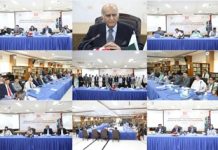The final episode of Saddam’s life, the trial and execution before cameras and videos flashed around the world, will have serious sectarian repercussions
Liberation, freedom, democracy and modernisation were some of the slogans that US leaders shouted at the media when they decided to invade Iraq about four years back. After deposing Saddam Hussain, they claimed that Iraq would be transformed into a model democracy for its neighbours in the Middle East to emulate. Contrary to these expectations, Iraq is edging fast to the brink of national disaster. There is a big question mark hanging over Iraq’s future: will it or won’t it remain one territorial unit? The trial and execution of Saddam Hussain is likely to fragment the country even more sharply. Its political vibrations will touch almost every Muslim country with sectarian divisions.
Owing to American occupation, continuing war and flawed policies of political reconstruction, Iraq’s national unity looks uncertain. The Iraqis are divided on almost every issue of national importance; efforts by the US and other countries to unite them around democracy, a new constitution and a new balance of power among three ethnic communities have miserably failed. Ethnic and sectarian consciousness is not a new problem in Iraq or in the region; it is as old as these states whose borders were drawn after the end of the Ottoman Empire. And ethnic diversity is not a problem itself, but it requires a different kind of politics to integrate various communities on the basis of representation and autonomy. It is through following these principles that multiple webs of partnership, interdependence and national solidarity evolve.
Iraq under the Ba’thist regime sowed its own seeds of destruction by adopting fascistic methods of highly centralised rule, marginalisation of Shias and Kurds, and reliance on brutality and repression to elicit obedience. Saddam and his regime had a lot of time on their hands to build a modern Iraq, using the twin ideologies of Arab nationalism and socialism. Unfortunately, the ideology of revival and Arab renaissance became elitist, retrogressive and abusive towards its own people, particularly the minorities. Over time their dream of equality, dignity and progress began to clash with the demands of the Ba’thist regime that wanted to create a unitary nation under a hegemonic political frame. The political order created through symbols, devoid of any political meanings, and dependent on threat or use of violence was self- destructive because it had no natural foundation in voluntary involvement of different communities or any sense of ownership.
Never did the Ba’thist regime demonstrate any genuine sensitivity towards the genuine aspirations of ethnic and sectarian communities. Even worse, it treated their resentment and feeling of exclusion as a sign of rebellion. Therefore, any hint of dissent, resistance or hidden design to challenge the regime was harshly suppressed. These fault lines were superficially covered by a reign of terror, and fear burst open with the first Gulf war. The Kurds in the north, under the protective umbrella of the US and Britain, established an autonomous zone, a kind of self-rule. The Shia in the south attempted revolt but Saddam’s army moved in to crush them violently. Each episode of violence, arrests and executions of dissidents earned the regime some reprieve, but inflicted wider and deeper political wounds.
When the coalition forces marched in to remove the Ba’thist regime, it had no natural defence within the communities of Iraq. Its army and other institutions, built with oil money over decades, withered away in weeks. Naturally, Kurds and Shias who had suffered humiliation, torture, and chemical attacks welcomed foreign invasion. They never concealed their joy and jubilation at the overthrow of the old regime, the toppling of Saddam’s statuette, his conviction and now his execution.
But the Arab Sunni population of Iraq have had from the beginning a very different take on the invasion. It was not a liberation but occupation of their country by foreign powers, that has no legal or moral justification. The Arabs in Iraq and those sharing their sentiment of national resistance from other Arab countries have waged a forceful insurgency. At an enormous cost of more than half a million dead Iraqis, and in the face of deadly air strikes and routine military operations, they have succeeded in shaking the American resolve to stay and fight in Iraq. They have raised the American material and human cost to a level where it seems that Americans are facing the same dilemma they did in Vietnam. By recent counts, the US has lost three thousand young men and women, and twenty-seven thousand wounded. The mainly Sunni insurgents have forced the US to rethink its Iraq strategy by shattering the consensus within the American establishment as well as among the western allies.
The occupation of Iraq and the ongoing war may have wider implications for the country and the region around it because of the divisions and sectarian conflict it has provoked. There is now a two-dimensional war; one against the foreign forces, particularly the Americans, and the other between the Shia and Sunnis. The Kurds are already behaving as an independent state, not allowing the Iraqi national army even a symbolic presence or the flying of the Iraqi flag in their region anymore. They have established a kind of hard border with the Sunni provinces.
The sectarian civil war during the past year has taken a heavy toll on the civilian population. The sectarian militias have proliferated, and most of them are involved in the worst kind of ethnic cleansing in their neighbourhoods. Some of the Shia leaders who found sanctuary and support in Iran during Saddam’s rule are allegedly getting massive material assistance from Tehran. To counter Iranian influence on Shia groups and their violence against the Sunni population, some of the Arab states and private groups have begun to support the Arab Sunnis in Iraq. The country is an ancient battleground of these two sects that have fought many bouts of war before. The current civil war is more dangerous because it may cause disintegration of the country, and the sectarian sentiment may spill over its boundaries. This is already happening in parts of the Middle East
The final episode of Saddam’s life, the trial and execution before cameras and videos flashed around the world, will have serious sectarian repercussions. The Sunni Arabs inside Iraq and outside have termed the execution as a revenge killing by the members of their rival sect. It was horrifying to hear one of the executioners taunting Saddam in his final moment and raising slogans in support of a Shia sectarian leader. These horrible sound-bites and terrible execution scenes reflect deep-seated communal prejudices and hatred. For the majority of the Sunni Arabs the event may transform brutal legacy of a tyrant into a legend of national sacrifice and martyrdom. The future of the Middle East looks gloomier with the arrival of the New Year, with the surge of communal hatred and ethnic conflict to which the brutality of the old regime and American war of occupation have greatly contributed.
The author is a professor of Political Science at the Lahore University of Management Sciences.












